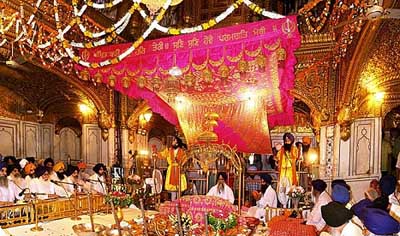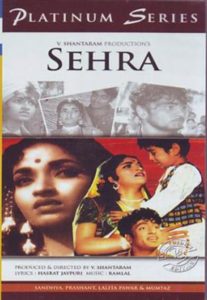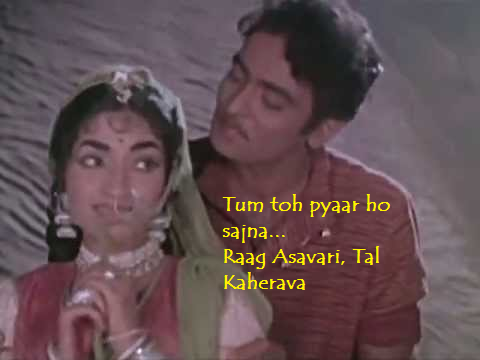Raaga Based Song of the Day: Tum toh pyaar ho sajna…
Raag Maru Bihag, Tal Kaherava
We have completed thirty-six days of Raaga Based Songs of the Day. Our first post in the series was titled ‘Raaga Based Song Of The Day #1’ and the song was a Mohammad Rafi and Lata Mangeshkar song from the 1970 Shakti Samanta movie Pagla Kahin Ka: Tum mujhe youn bhula na paoge. It is in Raag Jhinjhoti, Tal Kaherava.
Our thirty-sixth post was titled ‘Raaga Based Song Of The Day #36’ and the song was a Lata Mangeshkar song from the 1949 DD Kashyap movie Badi Bahen: Chele jaana nahin nain mila ke. It is in Raag Asavari, Tal Kaherava.
This blog has a number of posts on Raaga based songs in Hindi movies titled similarly; for example: ‘The Best Raaga Based Songs in Hindi Movies – Raaga Pilu – Part I‘.
In the last thirty-six days of sharing Raaga based songs of the day, I have given you songs based on Raag Jhinjhoti, Gara, Bhimpalasi, Madhuvanti, Shivaranjani, Bihag, Pahadi, Sarang, Pilu, Bhairavi, Khammaj, Charukesi, Kalyan or Yaman, Desh, Malgunji, Kirwani, Kedar, Bageshri, Megh Malhar, Bhupali, Ahir Bhairav, Malkaush, Adana, Kafi, Rageshri, Jaunpuri, Tilang, Janasammohini, Chayanat, Shuddha Kalyan, Gaur Sarang, Jogiya and Asavari. The only raag that has been repeated so far is Pahadi, the raaga of my home place.
Today, I give you a song in Raag Maru Bihag, Tal Kaherava.
However, first, lets take up the value added learning of today. Today, we shall learn about Kirtan:
At first instance, you are bound to ask me: “What is there to learn about Kirtan? We know it already.” Well, actually, there is a lot to learn. Kirtan is a Sanskrit word that means ‘narrating, reciting, telling or describing’ of a story or idea. In a religious gathering, Kirtan is a musical form of narration shared between the narrator and the congregation.
One can easily refer to Kirtan (Vedic anukirtana tradition) as song in which the narrator (kirtankara (or kirtankar)) or narrators takes a line in the hymn and expects the gathering to repeat the chant in the same melody. There are times when the singer’s singing is accompanied by dancing
Generally, the vocal performance by singers is accompanied by Harmonium and Tabla but may also include other instruments such as Mrdanga or Pakhwaj, Veena or Ektara, Flute, and Kartalas or Talas (Cymbals). The other day, in my home place Kandaghat, I attended a Kirtan performance for Sai Baba and they had a keyboard added too.
Kirtan is a routine practice in Sikh Gurudwaras, Vaishanavi devotion, and Sant tradition. Usually, Kirtan (as a form of eulogising gurus/gods) is accompanied by the singer pausing and telling the story (katha) and then resuming the singing.
The holy book of Sikhs is based on raagas and as I have been fond of saying, Sikhs carried forward the Vedic tradition of reciting scripture or religious texts through raagas with the accompaniment of music. In the Gurudwaras, a Shabad Kirtan is the musical recitation of the Sri Guru Granth Sahib itself.
Sikhs lay a lot of emphasis on Kirtan, generally performed by Ragi Jatha or those well versed in raagas. Generally, a Sikh Kirtan would be there in the forenoon before the final ardaas (prayer) on a Sunday. However, there are Gurudwaras wherein akhand kirtan (continuous unbreakable kirtan) takes place. The congregation in a Sikh Kirtan is known as Sangat or Satsang meaning ‘fellow travelers on a spiritual journey’.

You are bound to ask me at this stage what, if any, is the difference between Bhajan and Kirtan. Both have common objectives, and share similar raagas and subjects. A bhajan is generally singular and is more free flowing; whereas a Kirtan is generally more structured performance in which the singers and the congregation share a call and response form of singing.
As I mentioned, today’s song is composed in Raag Maru Bihag, Tal Kaherava.
Maru Bihag is a very melodious raaga that belongs to the Kalyan Thaat. It is to be sung during the second prahar of the night: from 9 PM to midnight. Its Jati is Audhav-Sampoorna. Maru Bihag is a variation of Raag Bihag in which I gave you the song Tere sur aur mere geet from Goonj Uthi Shehnai that had Shehnai-vaadan by Ustaad Bismillah Khan. In the Sri Guru Granth Sahib, Raag Bihagara occurs on 20 pages from 537 to 557 and is similar to its modern version: Raag Bihag.
Some of the other songs composed in Raag Maru Bihag are: Dil jo na keh saka(Tal Kaherava), Matwali naar thumak thumak (Tal Kaherava), Payal wali dekhana (Tal Kaherava) and Radha jaaye na (Tal Dadra).

I have taken today’s song from the 1963 movie Sehra directed by V Shantaram. The movie starred Sandhya, Prashant, Mumtaz, Lalita Pawar, Manmohan Krishan, Ulhas, Babloo, M. Rajan and Baburao Pendharkar. You would like the cinematography in the video of the song. Krishanrao Vashirde won the Best Cinematography (Colour) Filmfare Award.
Hasrat Jaipuri penned the songs of the movie and Ramlal Hirapanna composed them. The songs of the movie became very popular:
| 1 | Mast Nazar Ki Katar | Mohammed Rafi |
| 2 | Taqdeer Ka Fasana | Mohammed Rafi |
| 3 | Ja Ja Ja Re Tujhe Ham Jaan Gaye | Mohammed Rafi, Lata Mangeshkar |
| 4 | Tum Toh Pyar Ho Sajni | Mohammed Rafi, Lata Mangeshkar |
| 5 | Taqdeer Ka Fasana | Lata Mangeshkar |
| 6 | Pankh Hote To Ud Aati, Rasiyaa O Zalima | Lata Mangeshkar |
| 7 | Ujad Gaya Hain Mohabbat Main | Lata Mangeshkar |
| 8 | Na Ghar Tera Na Ghar Mera | Hemant Kumar |
| 9 | Hum Hain Nashe Mein | Asha Bhosle |
- Please enjoy Lata Mangeshkar and Mohammad Rafi sing in Raag Maru Bihag, Tal Kaherava: Tum toh pyaar ho sajna….
la : tum to
tum to pyaar ho sajanaa tum to pyaar ho
mujhe tumase pyaaraa aur na ko_ii
tum to pyaar ho sajanaa
ra : tum to pyaar ho sajanii tum to pyaar ho
mujhe tumase pyaaraa aur na ko_ii
tum to pyaar ho
la : aa kitanaa hai pyaar hamase ye to bataa do
ra : a.mbar pe taare jitane itanaa samajh lo
la : sach merii qasam
ra : terii qasam terii yaad hame.n luuTe
la : qasame.n to khaane vaale hote hai.n jhuuThe
chalo jaa_o haTo jaa_o dil kaa daaman chho.Do
ra : tum to pyaar ho sajanii …
ho o aake na jaa_e kabhii aisii bahaar ho
la : tum bhii hamaare li_e jiivan si.ngaar ho
ra : sach merii qasam
la : terii qasam tuu hai aa.Nkh ke til me.n
ra : tum bhii chhupii ho mere shiishaa-e-dil me.n
o mere hamadam mere hamadam merii baat to maano
la : tum to pyaar ho sajanaa …
do : tum to pyaar ho
We have intended to learn about Raaga based music whilst we entertain ourselves with Raaga based songs. So, lets, once again, take stock of our collective learning so far:
- On the first day we learnt about the Raaga system devised by Pandit Vishnu Narayan Bhatkhande, which is the prevalent system in Hindustani Classical Music and based on ten Thaats.
- On the second day we learnt about Tal or Taal.
- On the third day we learnt about characteristics of Raagas that included Swar, Jati, Thaat, Arohana and Avarohana, Vadi, Samvadi and Pakad.
- On the fourth day, we learnt about Sargam.
- On the fifth day, we learnt about notations used in Indian classical music or simply Swar Lipi.
- On the sixth day, we learnt about the Ras (sentiments) that Raagas evoke.
- On the seventh day, we learnt about various types of Swar: Shuddha, Achal, Vikrut, Komal and Teevra.
- On the eighth day, we learnt the parts of a composition in Indian Classical Music.
- On the ninth day, we learnt the names of some of the popular instruments used in Indian Classical Music.
- On the tenth day, we learnt about the sources of names of Raagas.
- On the eleventh day, we learnt about why Bhairavi is the first raag to be taught to beginners and also why it is the last in a performance.
- On the twelfth day, we learnt about Khammaj Thaat.
- On the thirteenth day, we learnt about Tal Punjabi Theka or Sitarkhani.
- On the fourteenth day, we learnt about Alap.
- On the fifteenth day, we learnt about List of Raagas (Raagmala) in my favourite book: Sri Guru Granth Sahib.
- On the sixteenth day, we learnt about tips for raaga identification.
- On the seventeenth day, we learnt the basics of Gharana system.
- On the eighteenth day, we learnt about Filmi Sangeet.
- On the nineteenth day, we learnt about the commonest Tal in Raagas: Tintal.
- On the twentieth day, we learnt about the Kafi Thaat.
- On the twenty-first day, we learnt a little more in detail about the classification of Raagas.
- On the twenty-second day, we learnt the essential differences between Bhairavi and Bhairav.
- On the twenty-third day, we learnt a little more in detail about the Jati or Jaati of a raaga.
- On the twenty-fourth day, we learnt details of Thaat Bilawal, the most basic thaat in the Bhatkhande’s system of raagas.
- On the twenty-fifth day, we learnt about Tintal.
- On the twenty-sixth day, we learnt in detail about the Raaga – Samay linkage.
- On the twenty-seventh day, we learnt about Lehar.
- On the twenty-eighth day, we learnt about the history of the Hindustani Music.
- On the twenty-ninth day, we learnt about Dhrupad.
- On the thirtieth day, we learnt about Rupaktal that I was introduced to, a few months back, by my friend Anand Desai.
- On the thirty-first day, we learnt about Khayal.
- On the thirty-second day, we learnt about Thumri.
- On the thirty-third day, we learnt about Tappa.
- On the thirty-fourth day, we learnt about Tarana.
- On the thirty-fifth day, we learnt about Tal Dipchandi (Moghali).
- On the thirty-sixth day, we learnt about Tabla.
- And today, on the thirty-seventh day, we learnt about Kirtan.
There is much more still to be learnt and enjoyed.
Please stay tuned!
